Living Museum of the North steam gala
Posted by Chris Graham on 17th August 2022
David Reed visited Beamish, The Living Museum of the North during its Steam Gala earlier this year, and reports on a fantastic event.

Living Museum of the North: The road train climbing the hill with VM 2110 1928 Fowler B6 8hp No. 17105 Atlas leading the way, followed by 1925 Fowler B6 No. 16263 Talisman. The order of the engines at the back was constantly changing.
For anybody looking for a suitable period location to photograph traction engines and early commercials, Beamish has to be the place. This world-famous open-air museum, which is situated near Stanley in County Durham, just south of Newcastle-Upon-Tyne, hosted its first Steam Gala for a couple of years, where visiting engines and commercials complemented the museum’s other attractions. It was a slightly smaller show than those held before the lockdowns, with the original four-day event now taking place over two days. Around 20 steam vehicles were on site and another 25 that were powered by the internal combustion engine on view.

A 1954 Scammell 15MU that was new to Shell Mex in London, passing to Land & Lawn Co of Bournemouth in 1969. It is seen leaving the main town street at Beamish.
This was not a static show, with exhibits running around the museum’s 1½ mile road system, competing for space with the trams in the impressive town street, all adding to the historic atmosphere. But of course it is the period settings that bring the museum alive, with the steam engines rumbling down the main street, passing shops and other business along the way. It was an impressive sight indeed.
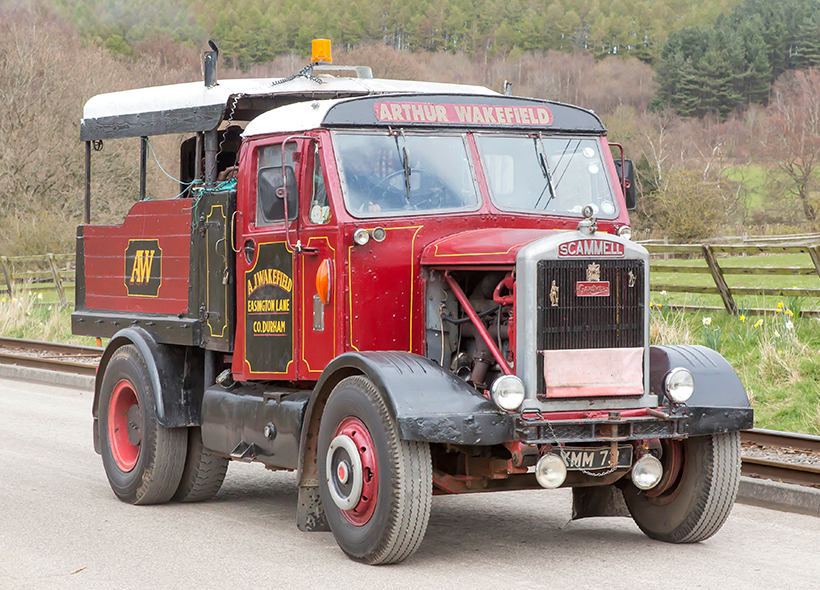
Arthur Wakefield’s 1946 Scammell ballast box was new to Guinness, seeing service later on the fairground. It is seen on the road around the site, heading towards the wagonway.
As well as the steam vehicles, the cars, motorbikes and commercials were getting lots of attention too.
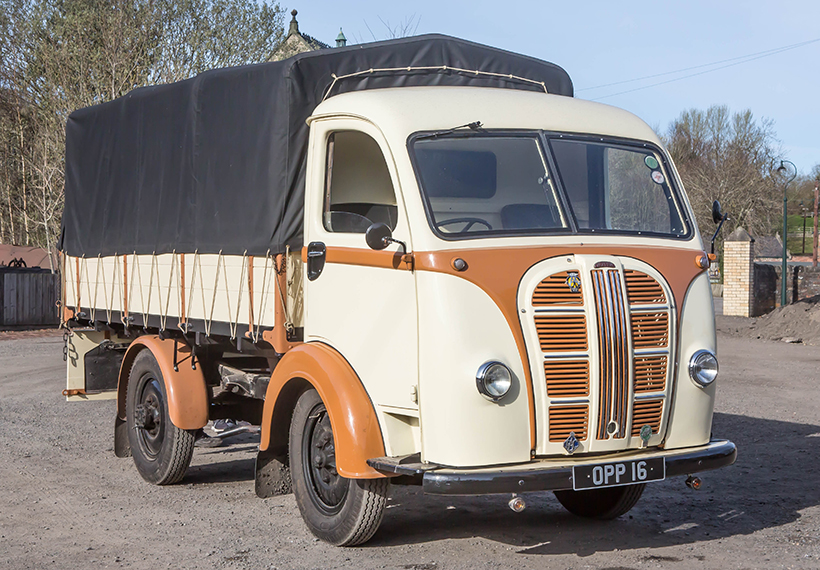
Seen at the colliery, this 1951 Austin K8 dropside was new to greengrocer Ralph Eames of Bletchley and was used to collect produce from the old Covent Garden market in London.
Resident commercials included YG 5825, a 1933 Morris Commercial 30cwt fitted with a box body. This vehicle was used by J H Jerry of South Shields from new although it was stored for many years before being restored by the family and allowed to join the Beamish collection. A recent Beamish acquisition was JTC 893, a 1948 Albion Chieftain flatbed, while BV 1673 is a 1932 Leyland Cub KG2 tipper that was supplied new to Blackburn Corporation Transport and ended up at Leighton Buzzard from where it was donated to the museum in 2020.

YG 5825 is a 1933 Morris Commercial 30cwt which is fitted with a box body. It was used by J H Jerry of South Shields for all its working life.
OPP 16 is an Austin K8 dropside that was first registered in 1951 in Buckinghamshire, to greengrocer Ralph Eames of Bletchley, and used to collect produce from the old Covent Garden market in London. It seemed that the end was in sight though when the K8 was left in a field, before being sent to be scrapped in the mid-80s. But it was rescued for restoration and passed through the hands of a number of owners being extensively restored, then finally it was donated to the museum.

BV 1673 is a 1932 Leyland Cub KG2 tipper that was supplied new to Blackburn Corporation Transport and ended up at Leighton Buzzard from where it was donated to the museum in 2020.
Doing sterling service over the weekend was FM 7443, a 1933 Leyland Cub bus that was delivered to Crosville and numbered N33. Withdrawn from service around 1950, it was converted into a mobile enquiry office and then sold to a builder as a site office. It was saved by Tom Hollis, then it was eventually bought by Beamish in 2014 and has been sympathetically converted with a rear lift for disabled access.
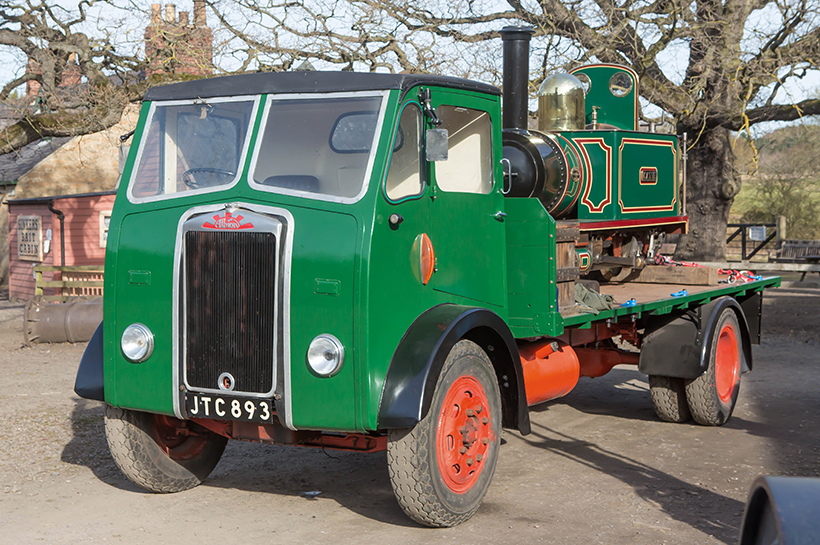
This 1948 Albion Chieftain was seen in the colliery yard, it has recently been donated to Beamish Museum.
Visiting commercials saw ANK 969, a 1936 Dennis 45 cwt Type A that was used by the LMS at St Pancras Station in London as a railway yard dray. Two visiting Scammells included NLR 269, a 1954 Scammell 15MU that was new to Shell Mex in London, passing to Land & Lawn Co of Bournemouth in 1969, while also on the scene was XMM 73, 1946 Scammell ballast box that was new to Guinness. In later life this Scammell saw service on the fairgrounds, transporting a big wheel with Furboroughs of Leicester, before passing to Arthur Wakefield of Houghton-le-Spring for restoration.
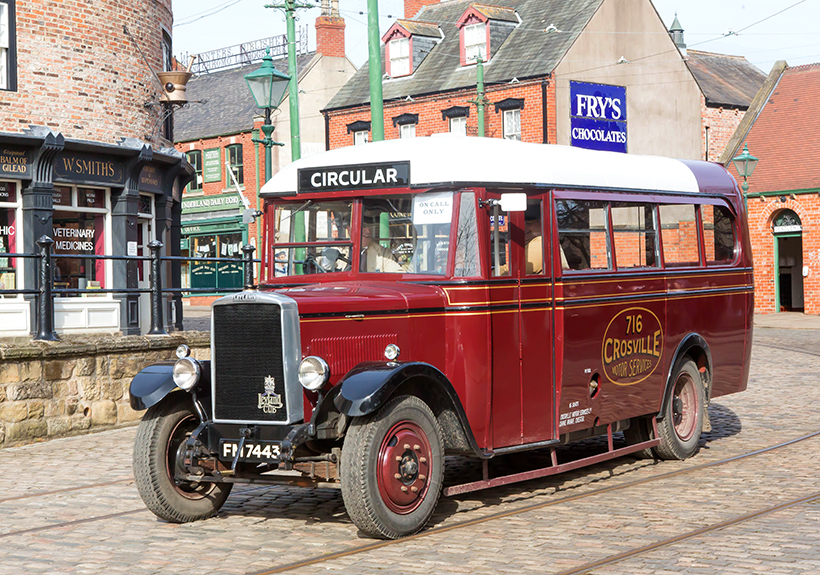
FM 7443 is a 1933 Leyland Cub ex Crosville bus. Arriving at Beamish in 2014, it has been sympathetically converted with a rear lift for disabled access.
There was a good selection of cars in attendance too, with some very early models to be seen, for instance a 1902 Arrol-Johnson 10/12hp dogcart registered SA 88 with chassis number 57 caught the eye. Its early ownership is unknown, but in the 1960s it was found derelict in a quarry by George Strathdee of Aberdeen, who restored the car and re-licensed it in 1972. Even earlier was M115, a 1901 Progress which is one of only two that are thought to survive out of 500 built.

This 1902 Arrol-Johnson 10/12hp dogcart was found derelict in a quarry in the 1960s by George Strathdee of Aberdeen, who restored the car and re-licensed it in 1972.
There were a number of Stanley steam cars running around the roads, including BS 8125, Simon Webb’s 1903 Stanley BX that actually belonged to his grandfather in Suffolk before it passed to him some 12 years ago. BS 9472 was a Model 62 and dated from 1911. This example was brought to the UK in the 1930s, restored around 2003 and it was bought by 2009 by Don Cook of Barnard Castle.

ES 4509 – this 1922 Matchless H motorcycle sidecar combination was getting a lot of attention and is seen near the wagonway at Beamish.
In mint condition was G 763, Mark Farrell’s 1905 Albion 16hp A3 twin cylinder petrol landaulette. that was bought from a museum in Switzerland in 2019 after being restored in 2008, “It still has its original body and wings,” Mark said.
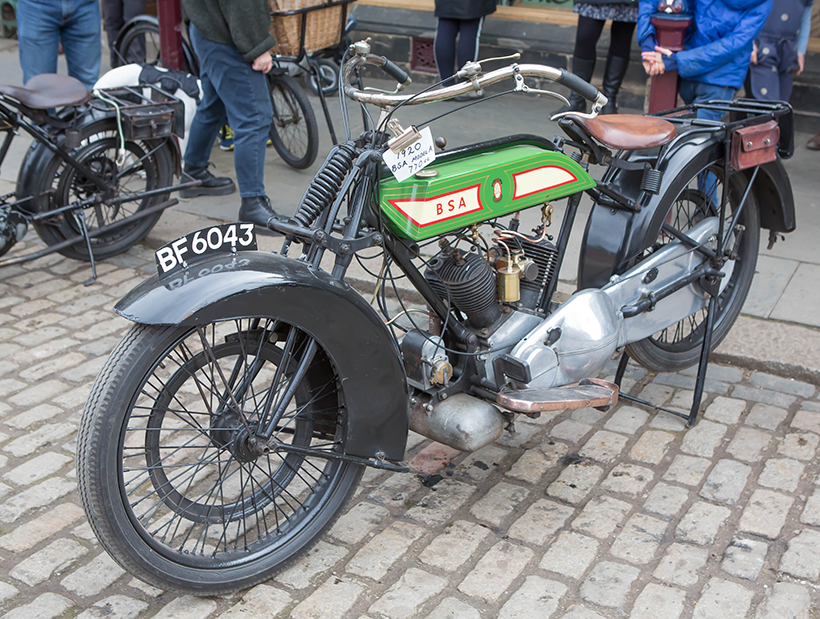
Seen outside the Co-op in the main street was this 1920 BSA Model A 770cc motorcycle.
Then came M 7371, a 1914 Newton Bennett tourer. Built in Turin, Italy, it is recorded that about 1,000 were built and marketed in England by Newton & Bennett of Manchester. This car was first registered in Cheshire in 1915 to a Mrs Townsend of Gorstage Hall, Sandiway, Northwich, who last licensed the car in 1932. The car was actually bought by its designer, John Newton, at auction in 1945.
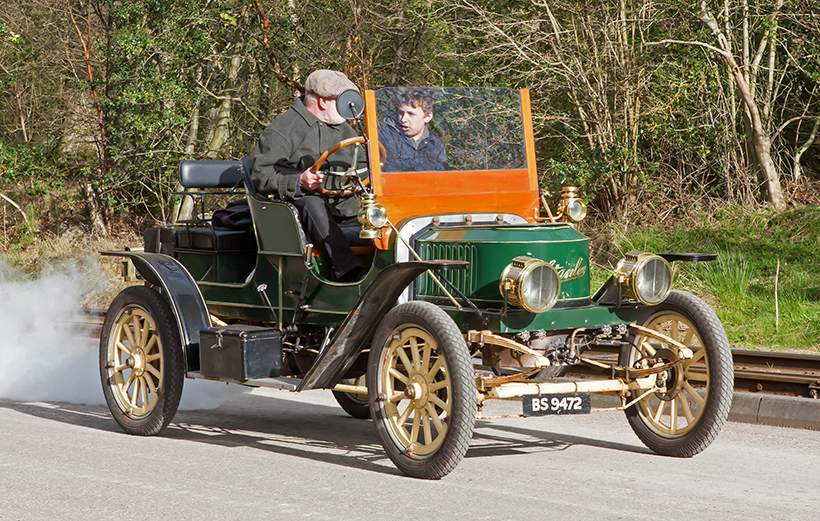
BS 9472 is a 1911 Stanley steamer Model 62 10hp roadster that was brought to the UK in the 1930s. It was bought by 2009 by Don Cook of Barnard Castle.
Among the other cars at Beamish over the weekend, a 1915 Swift 10hp tourer registered M 4759 stood out, as did RY 7315, a very tidy 1924 Morris Cowley light van, and DP 8798, a 1927 Austin 7 AD Chummy Tourer. Then came RX 5468, a 1929 Humber 16/50 which was one of 6,828 examples of this model that were built, while a 1925 Morris Oxford Bullnose also caught the eye as did BF 9661, Duncan Pittock’s 1923 Dodge tourer which came from Canada in the late 1980s.

1905 Albion 16hp A3 twin-cylinder petrol landaulette. It was bought from a museum in Switzerland by Mark Farrell in 2019 after being restored in 2008. It still has its original body and wings.
Of course there were a few Ford Model Ts to enjoy with 2 KYY dating from 1913, while very much in working condition was BF 7639, a Model T that dated from 1927. This was actually a flatbed with the worn livery of Pie Bob’s Bakery of Arbroath, and carried an authentic-looking load of sacks around the site.
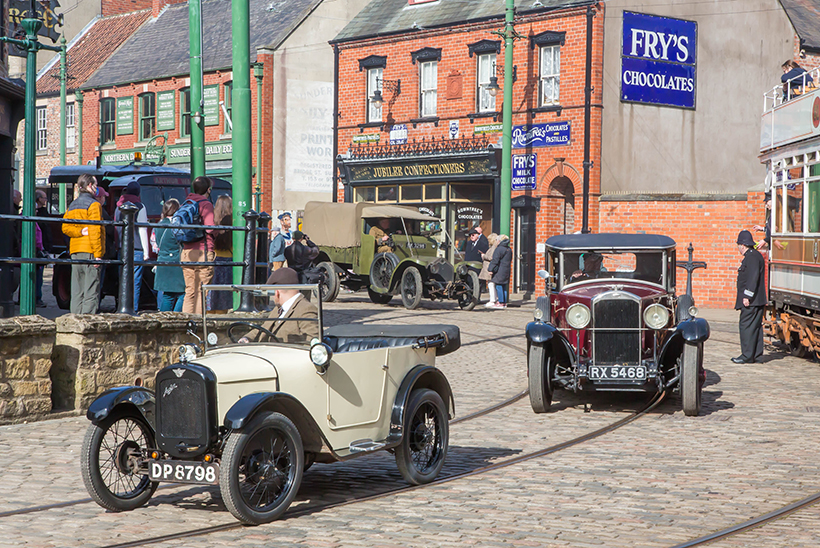
Seen in the town street is DP 8798, a 1927 Austin 7 AD Chummy tourer with 1929 Humber 16/50 RX 5468 close behind. Both have managed to avoid the Blackpool tram, and a police officer!
And finally, a 1918 Crossley Royal Flying Corps tender was a reminder that many of these vehicles were on the roads during WWI. The service history of the Crossley was not known, but subsequently it was available as a towing vehicle from a garage in Basingstoke until 1965, but was apparently not used. After passing through a couple of owner’s hands, it was bought by Tom Fryers of Gisburn who did the mechanical restoration.
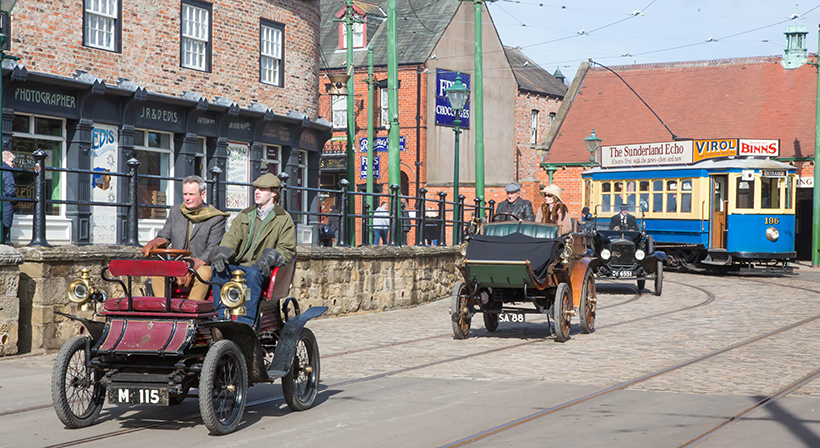
Seen in the town street is M115, a 1901 Progress was built by the Progress Cycle Co of Coventry, with a 1902 Arrol-Johnson 10/12hp dogcart close behind.
There were a large number of motor cycles to be seen too, including BF 6043, a 1920 BSA Model A 770cc, with ES 4509 being a very smart 1922 Matchless H motorcycle sidecar combination. One interesting example in this category though, had to be DS 9274, a 1924 Royal Enfield Model 182 V-twin motorbike and sidecar combination that has been converted to a milk delivery cycle complete with bottles – and a cat! It is owned by Stan and Moira Bartle and was certainly getting a lot of attention. “Bartle was restored from a pile of bits,” Stan said. But for those who were slightly more adventurous there were also some bicycles on the road, with Mark Entwistle on his penny-farthing possibly being the bravest of all.
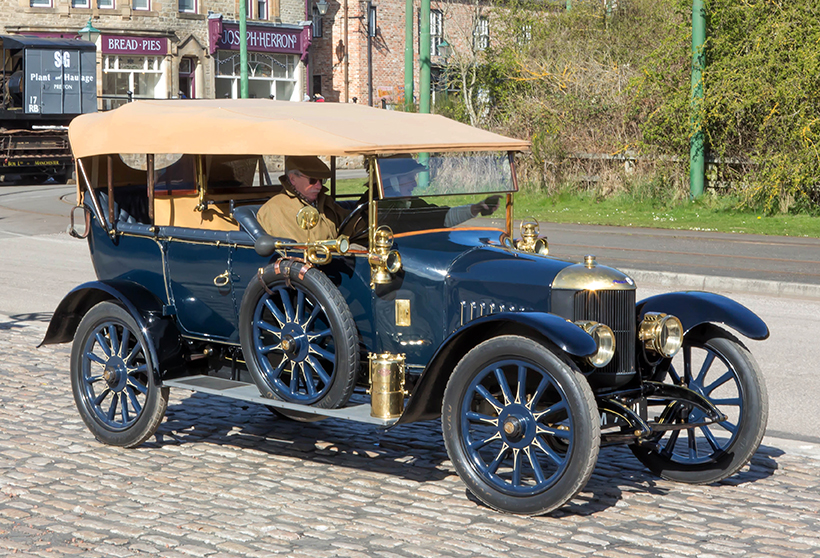
Seen near the 1950s street, M 7371 is a 1914 Newton Bennett Tourer that was built in Turin, Italy. One of its owners was the car’s designer John Newton who bought it in 1945.
As would be expected, the trams at Beamish were a great attraction, with cars from Blackpool, Newcastle, Sheffield, South Shields and Sunderland constantly running around the site.

In superb condition, this 1913 Ford Model T is seen near the main street in the town, a superb setting.
But steam is the big draw, and those that attended the event won’t have been disappointed. Seen working in the colliery area was 1915 0-4-0ST R2 class that was built by Peckett & Sons to work at the Yates Duxbury & Sons paper mill at Heap Bridge near Bury where it worked until 1970 when the steam brakes failed.

Seen in the town’s street, and wearing its working clothes, this 1927 Ford Model T flatbed wears the livery of Pie Bobs Bakery of Arbroath. It carries an authentic-looking load of sacks.
Seen on the Pockley wagonway was a replica of William Hedley’s 1813 loco Puffin’ Billy which was providing the power for a passenger train in an early 1800s style, while also in steam at the colliery was 1871 0-4-0VBGT ‘coffee pot’ No. 1 vertical boiler shunting engine. Built by Head Wrightson at their Thornaby works on Teesside, it was delivered new to Dorking Greystone Lime Company for use at their Betchworth Quarry in Surrey where it worked until 1949.
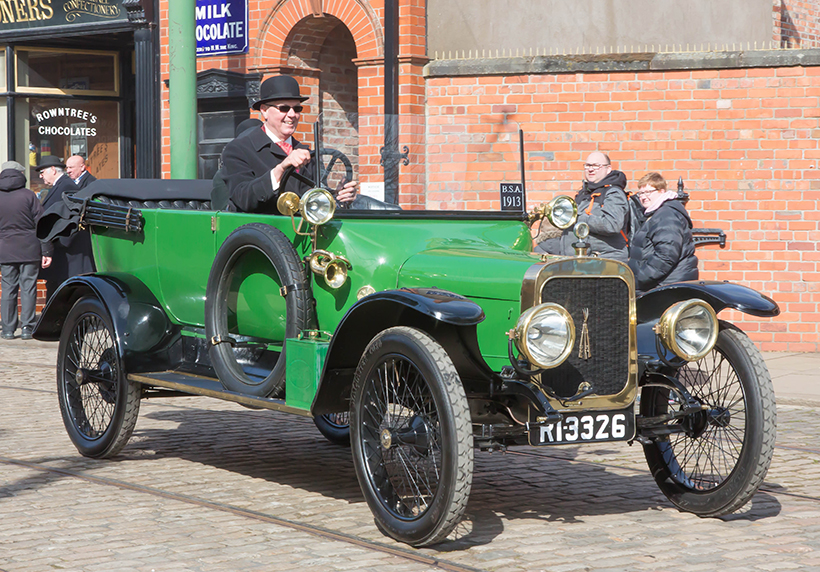
This is a 1913 BSA, and is possibly a Crichton Torpedo tourer. It is seen on the roads around Beamish. Not sure about this one. I never spoke to the owner and it is suggested that it is a Crichton Torpedo tourer, but that might be wrong!
There was also some narrow gauge steam to enjoy, with Lewin 0-4-0 replica Samson seen in action. The original was built in 1874 and was the first successful engine built by Stephen Lewin of Poole in Dorset. It spent all of its working life in a Durham Dales mine until being scrapped in 1904. Luckily though, Beamish volunteer David Young has recreated this engine from a surviving photograph, with the replica being completed in 2016.
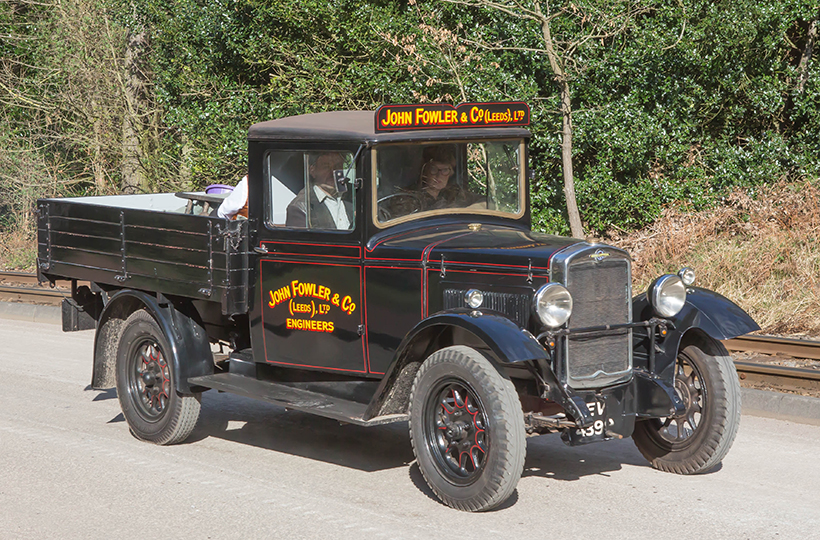
EV 4399 is a 1932 Morris Commercial pick-up and has been restored as a John Fowler vehicle.
Also on narrow gauge duty was visiting 1922 Kerr, Stuart 0-4-0ST Wren Class locomotive Peter Pan, which was working with 1931 Barclay 0-4-0WT No. 1994 Glyder. This loco was originally named Grey, and was supplied to the Durham County Water Board to work on the extensive Burnhope Dam contract in the early 1930s. After that contract was complete, it was sold in 1938 for further use on the extensive Penrhyn Quarry Railway system in North Wales where it received its current name. After withdrawal in 1965 it was exported to the US, but ended up being stored until coming back to the UK in around 2012.

Seen on the roads around Beamish, this 1915 Swift 10hp tourer was in very good condition.
The main steam attraction was the traction engines. Starting things off was 1926 Garrett compound steam wagon No. 34932, that was bought new by haulage contractors William Aitken of Linlithgow in Scotland. It was Aitken’s fleet No 20, but didn’t seem to live up to expectations so was returned to Garretts six months later. Garrett eventually sold the wagon, and another one like it, to Devon County Council with the engine spending its working life in the ‘Northern Division’ conveying quarry materials and roadstone to various projects around the county. Upon retirement in the late 1950s and after a couple of years on the rally field, it was bought by collector Charles Matthew Snr. of Toronto and exported to Canada, and there it remained until it was brought back to the UK by the Brown family of Ladybank in Scotland.

DS 9274 is a 1924 Royal Enfield Model 182 V-twin motorbike and sidecar combination that has been converted to a milk delivery vehicle by Stan and Moira Bartle.
Having a more local feel was BUP 71, 1929 Foden 4hp tractor No. 13218. Named Cestria, it was built as a six-wheeled wagon, but was later cut down to a tractor for timber extraction. It was bought in 1955 for preservation by Henry Thomas and is now owned by Ian Thompson of Chester-le-Street.
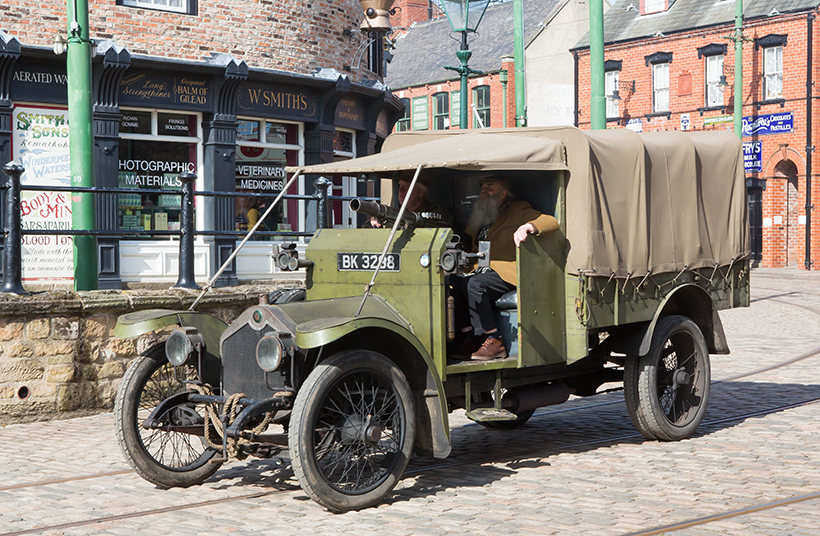
Seen on the town street, this 1918 Crossley Royal Flying Corps tender served in WWI before being available for use as a towing vehicle at a garage, but was never used.
One of the smaller engines was 1920 Clayton & Shuttleworth 4hp tractor No. 48427 which was used as a works engine and moved boilers and dead engines around the site. In 1934 though, the tractor was sold and renumbered 49008, being used on timber work in Herefordshire before passing into preservation. Now it is a regular on the rally field and has been owned by Peter Thompson of Warkworth in Northumberland for 35 years.
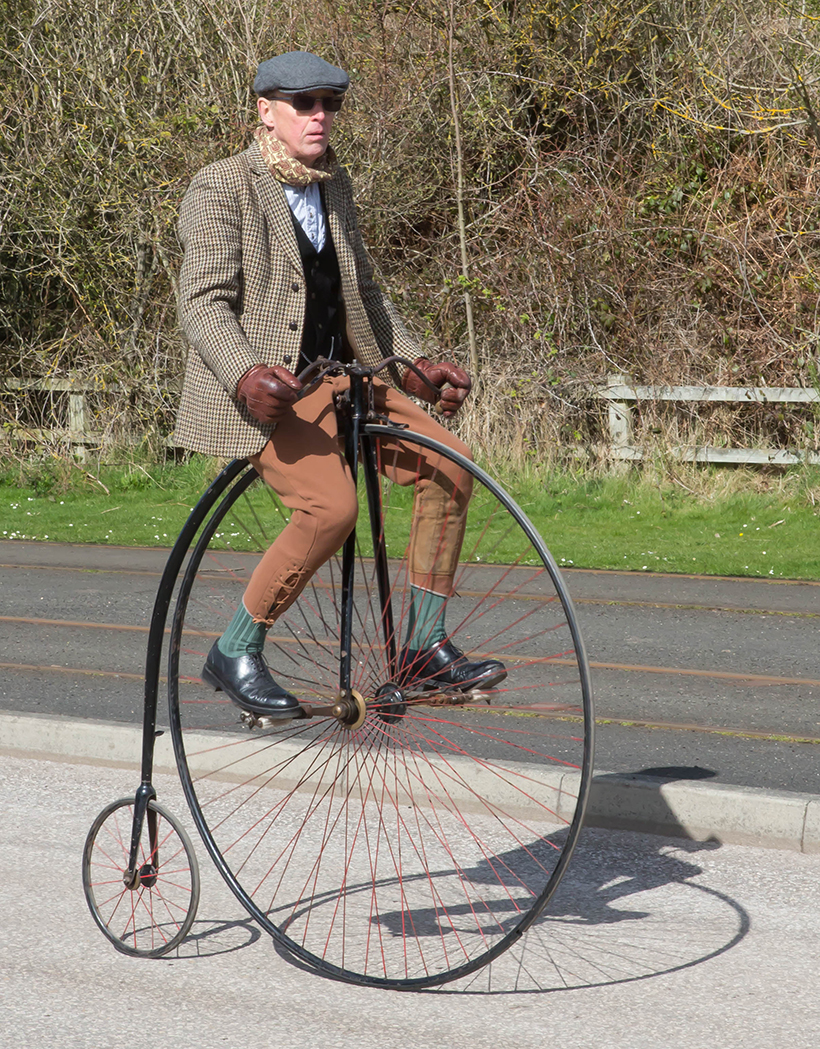
Braving the roads was Mark Entwistle who had to keep his wits about him as he rode his penny farthing bicycle on the Beamish roads.
A couple of general-purpose engines of note included 1906 Clayton & Shuttleworth No. 38742, Louise. This engine was delivered as a convertible to the Marquis of Zetland at Richmond in North Yorkshire when new, and was apparently still being put to use, towing a Land Rover Defender at Beamish. The other GP engine was 1889 Marshall 8hp No. 17134 Mary Margaret which had the honour of being exhibited at The Royal Agricultural Show at Windsor when new. After that, the Marshall was delivered to J R Barley, a firm of threshing contractors in Thirsk, and remained in North Yorkshire until preservation. It was bought in 1994 by Michael Davison of Bishop Middleton in County Durham with a full restoration following.
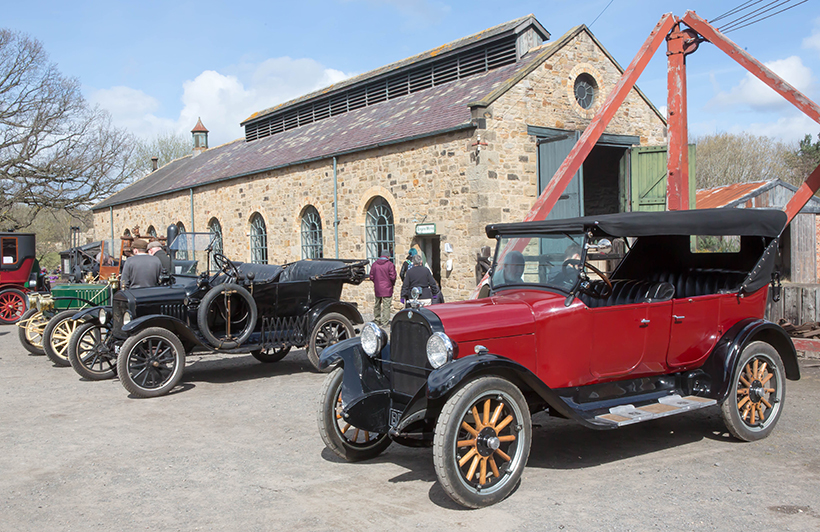
A line-up of vintage cars at the colliery during the weekend.
Having a more varied life was 1908 McLaren three-speed 6hp road locomotive No. 1012 Micks Mac. This engine was exported to New Zealand and was employed at Hawks Bay on North Island for around eight years before being used on South Island. Around 1940 though, it was deemed to be surplus to requirements and was unceremoniously dumped in a river bed to stabiise the bank and there it remained until the 1970s when it was found and dug out. It was brought back to the UK by Mick Gaines-Burrill of Swainby. “When it came back, the front wheels, cylinder block and crankshaft were good, but that was it,” Mick said, “Everything else is new including the boiler, gears and motion.” Bill Summerall of New Zealand helped with the restoration, “I worked under supervision,” Mick said.
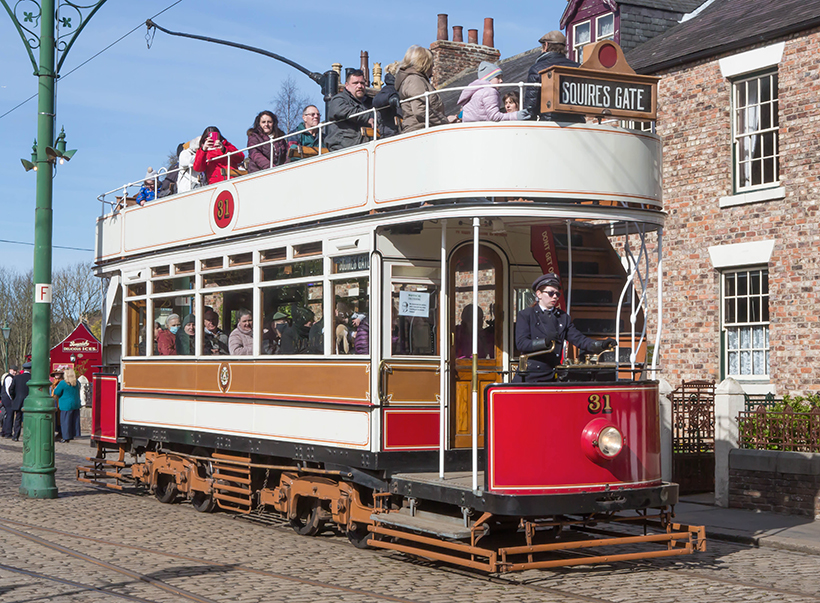
There was a good crowd on Blackpool tram No 31 as it entered the main street. It was built in 1901 by the Midland Railway Carriage & Wagon Co Ltd and was rebuilt in 1918.
There were also a pair of showman’s conversions on site. Bought in 2020 by Jonty and Val Hutchinson, their 1927 Fowler DNC 6hp No. 16971 Murphy was originally a roller and has carried the name Queen of Askam, while YA 44 is 1905 Fowler R1 7hp compound No. 9393, aptly named Sir John Fowler. This engine was originally a road locomotive and was sold new to Lalonde Bros. & Barham of Weston-Super-Mare, Somerset who were long-distance furniture removers. In 1921 it passed into the ownership of Gilbert Anderton and Betty Haslam and was converted for showland use, travelling with Anderton & Rowland. By 1926 the Fowler had been put up for sale, and passed through the Noyce family of Petersfield, Hampshire. and later to Jim Seward. It stayed with the Seward family until 1969 when it was sold into preservation and exhibited on a regular basis. Sir John Fowler now resides in Scotland with the Cook family, and has received an eight-year full nut-and-bolt restoration with a new boiler and gears being fitted.
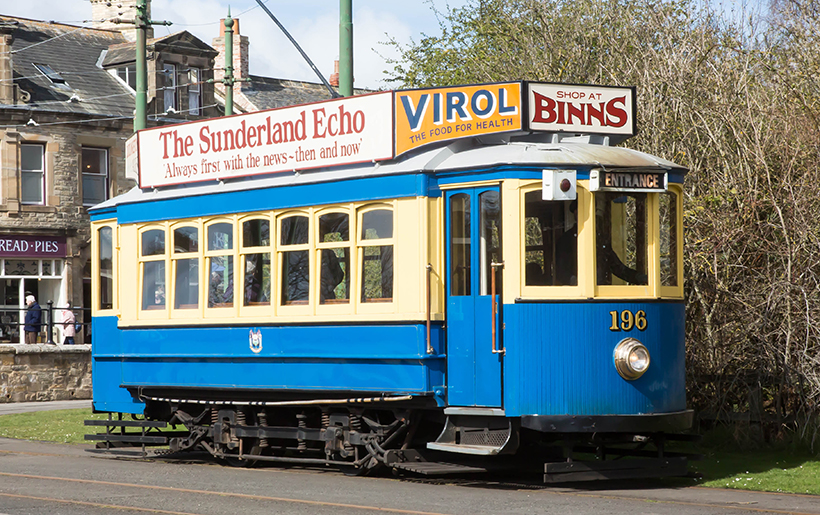
Tram 196 was built in 1935 at the Boavista Works of The Oporto Tramways Company. It was bought by Beamish in 1989 and now wears South Shields’ livery.
When it came to the rollers, a very smart combination caught the eye. This was TN 216, the 1925 Aveling & Porter D Class No. 11145 named Ayesha, which was new to C S Bunch of Jesmond, Newcastle and was used by them until the 1960s. After a couple of owners, it passed to Alan Borthwick of Houghton-le-Spring some 24 years ago, while the oldest roller on view was BS 8711, David Bickerdike’s 1904 Aveling & Porter R6 No. 5499. This example spent its working life overseas and was repatriated from Germany in around 2012, “It has had a full restoration which took ten years on and off,” I was told.
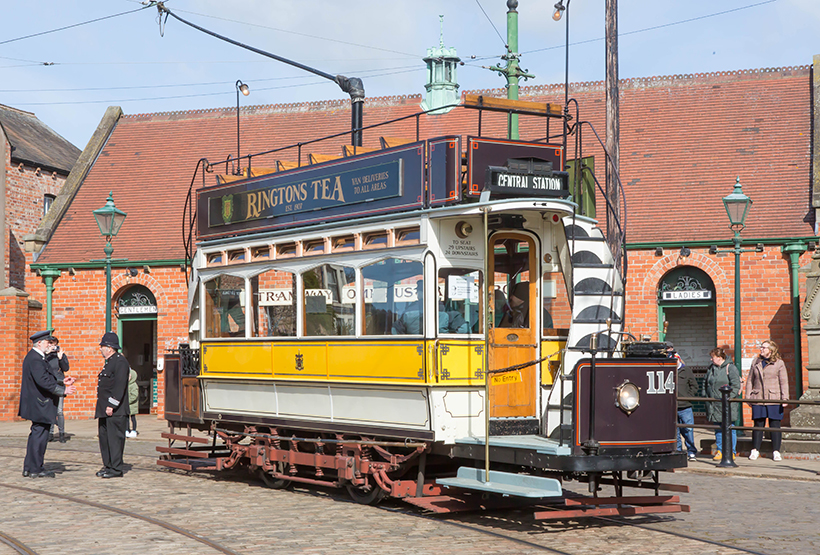
Built in 1901, this A-class tramcar was built in 1901 by Hurst Nelson & Co Ltd, Motherwell, for Newcastle Corporation Tramways and carries the fleet number 114.
The smallest roller at Beamish was FE 6255, Phil Moody’s 1924 Robey tandem No. 41593 which worked until the early 1960s for Flintshire County Council before passing through the hands of a couple of owners in preservation.
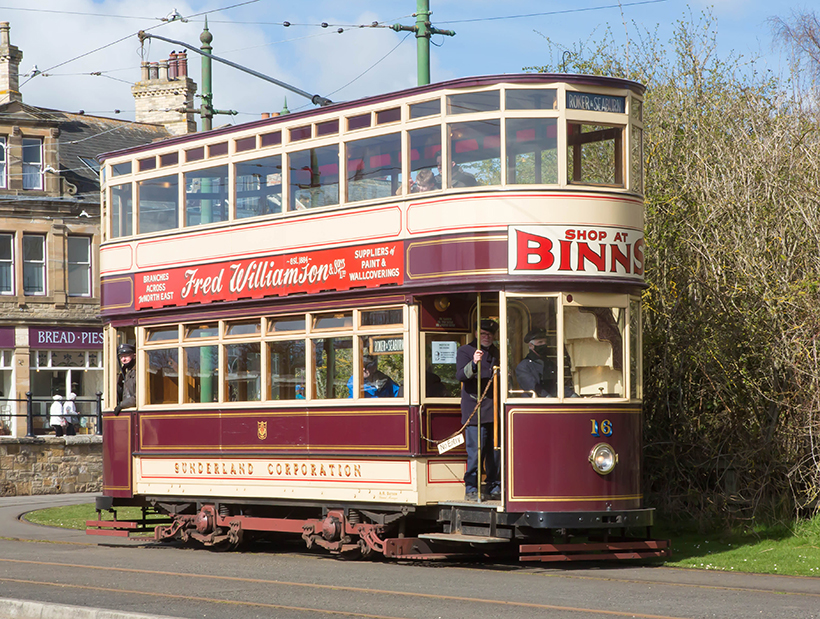
No 32 Sunderland Corporation Tramways No.16 was built as an open-top tramcar by Dick, Kerr & Co of Preston, in 1900.
It was probably no surprise that the Fowler name dominated among the engines on display. Continuing the roller theme, Beamish Museum’s own 1925 Fowler 10-ton single cylinder roller No. 16615 was also to be seen on the road, a machine that was operated by Gosforth Council until 1964 before being presented to Beamish Museum by The Tyne Industrial Archaeology Group in 1970.
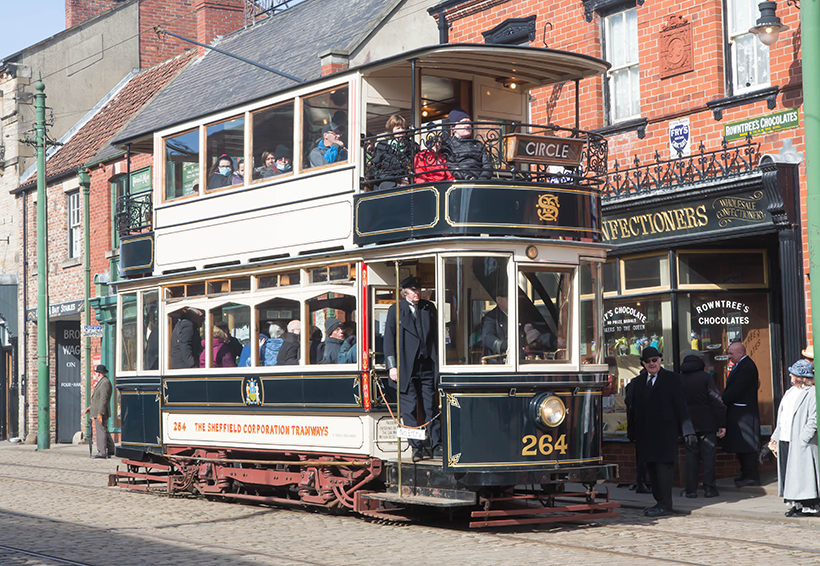
Sheffield Corporation Tram No. 264 at one of the tram stops at Beamish.
Continuing the theme, 1920 Fowler l7hp A9 compound road locomotive No. 15649 Providence was getting a lot of attention. Originally used for threshing in Derbyshire, it passed to the Stafford family of Hetton-le-Hole in 1955, and was used for heavy haulage. One notable load during the 1960s was the miniature-gauge locomotive River Mite, which was transported from York to the Ravenglass & Eskdale Railway. To recreate this journey, Providence was pulling a trailer carrying the ‘Ratty’s’ 1929 Krauss Pacific steam locomotive Whillan Beck which was on loan from the railway. As for Providence itself, that remains with the same family, being owned by Howard and Barry Stafford.

This is 1871 0-4-0VBGT No 1 vertical-boilered shunting engine ‘coffee pot’ that was built by Head Wrightson at their Thornaby works on Teesside, and was seen working at the colliery.
Seen in the colliery area at Beamish was 1928 Fowler B6 10hp compound crane engine No. 17106, Duke of York. This very popular machine was new to Marston Road Services of Liverpool in 1928 where it was used to haul girders and transformers. It was last used commercially in the 1960s and passed to Paul Scholey in 1985 who has fully restored the engine, including fitting a new barrel and motion, and more recently, new tyres.
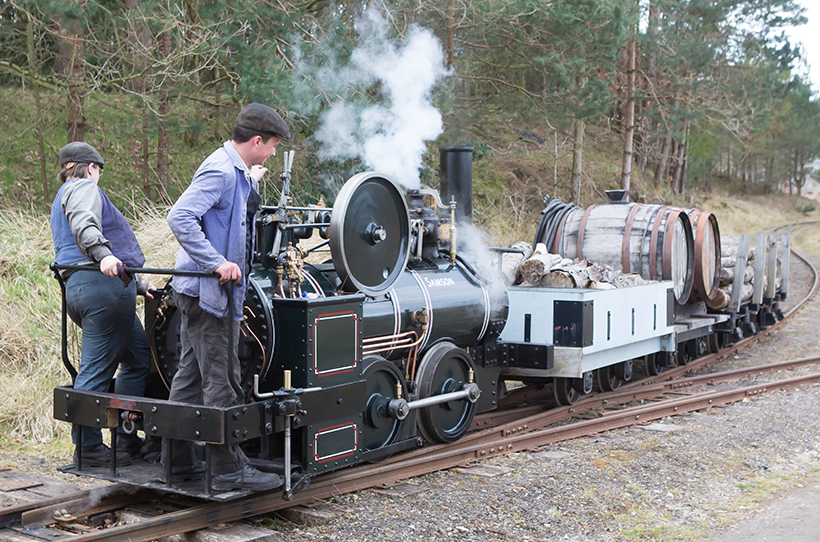
Seen on the narrow-gauge railway was a replica, built by David Young, of Lewin 0-4-0 Samson, which worked in the Durham Dales until being scrapped in 1904.
Equally impressive was 1913 Fowler A6 road locomotive No. 13141 that was new to M Thorp of Basingstoke and was used by him for contract haulage until his death in 1942. It was sold to Thurlows of Stowmarket and used by Hampshire War Agricultural Committee before passing to the Sheffield area in 1947 where it was used for threshing. The engine is now with Jeremy Davies of Avon Dassett in Warwickshire and was seen pulling a period wagon with original timbers.
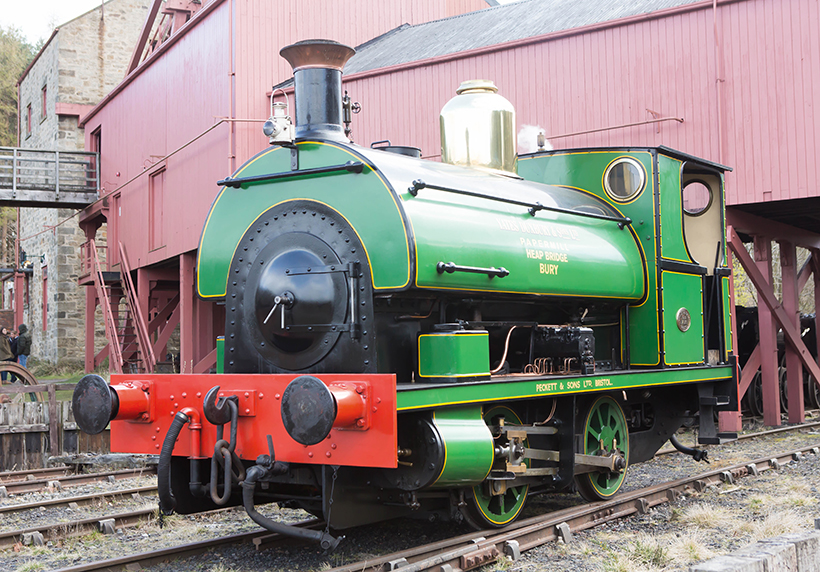
This 1915 Peckett 0-4-0ST R2 class locomotive was to be seen working in the colliery area, although it sometimes is to be seen on the station area.
On a smaller scale was 1920 Fowler 3hp Tiger tractor No. 15625 that was built for light road haulage, being new to Westmorland County Council in 1920 and used until 1953 hauling timber and stone. It was bought by D Mitchell of Guisley in 1956 for preservation, later passing to Richard Metcalfe of Sutton near Macclesfield in around 2018 and given a full restoration.
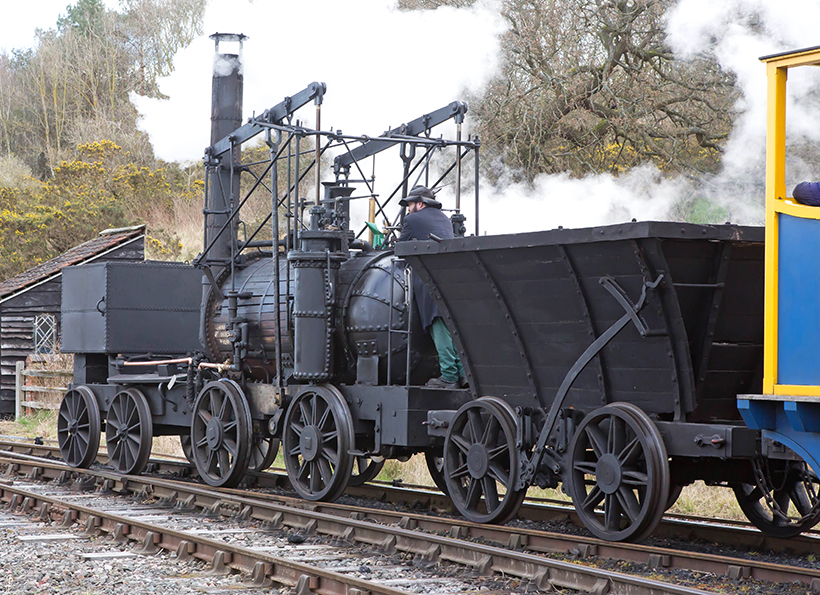
Seen working on the Pockley wagonway, this replica of William Hedley’s 1813 loco Puffin’ Billy was hard at work over the weekend.
But getting all of the attention was Alex Sharphouse’s superb Ruston Bucyrus 17RB face shovel, the was being hauled around the museum with up to four traction engines taking the strain. The place to observe this from was the stiff climb near the main entrance, where the sight of the road train powering to the top was spectacular indeed.
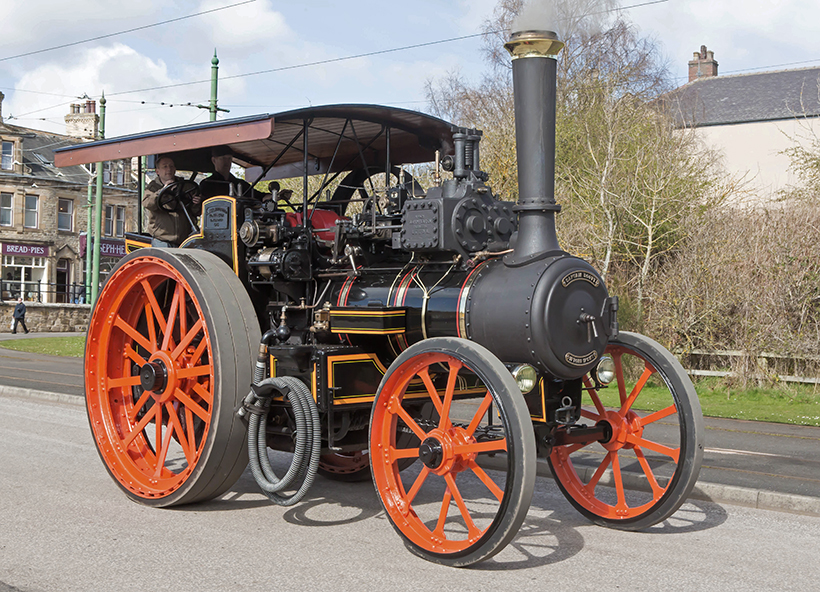
Will Woodward’s 1913 McLaren 12-ton 8hp road locomotive No 1421 Captain Scott saw service in WWI on airfield construction. The engine looked superb after its refresh.
Although the configuration changed from time to time, 1911 Fowler B6 road locomotive No. 12906 Foremost was frequently on duty. This engine was new to Charles Openshaw of Reading and was used for furniture haulage up until WW1 when it was sent to Southern France although its involvement in hostilities is unclear. Found by Richard Willcox, Foremost returned to the UK in 2008 and was bought by Joe and Linda Walker of Derby that year, with restoration starting in 2009 and being completed in 2013.
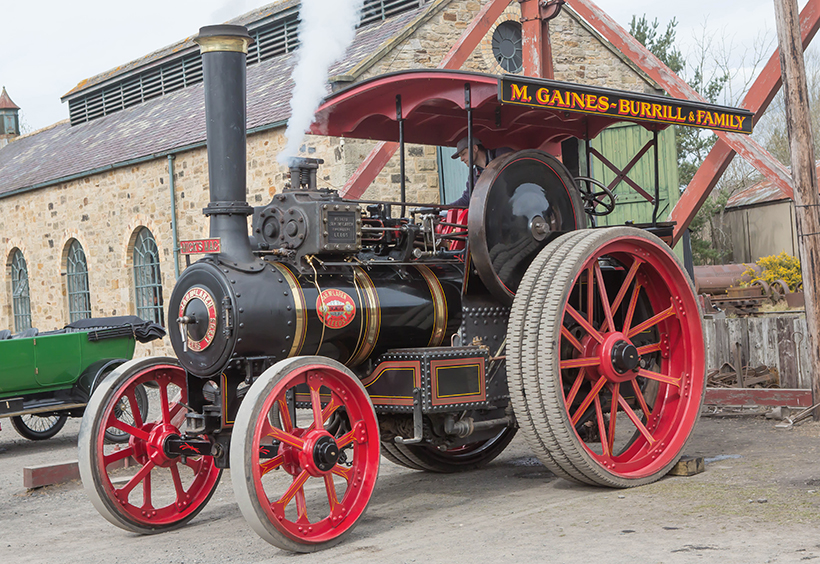
Mick Gaines-Burrill’s 1908 McLaren 3-speed 6hp road locomotive No. 1012 Micks Mac looks like it could be overtaken by a 1915 Swift 10hp tourer.
It was no surprise to see Alex Sharphouse’s 1925 Fowler B6 road locomotive No. 16263 Talisman in the line-up. Originally built for the heavy haulage firm of Norman E Box of Manchester, it has been completely rebuilt using original parts, while 1928 Fowler B6 8hp compound road locomotive No 17105 Atlas was seen working hard. This was another engine that was new to Norman E Box, being amalgamated into the Pickfords fleet when they took over the company in 1930. After passing through the hands of other hauliers, it was bought by Dr James D Coombs of Ashley Guise, Bedfordshire in 1985 and moved on to James Hervey-Bathurst of Eastnor Castle Estate a couple of years later. Now Atlas is with Mike Dreelan of Aberdeen who has completely restored the engine to its present condition.
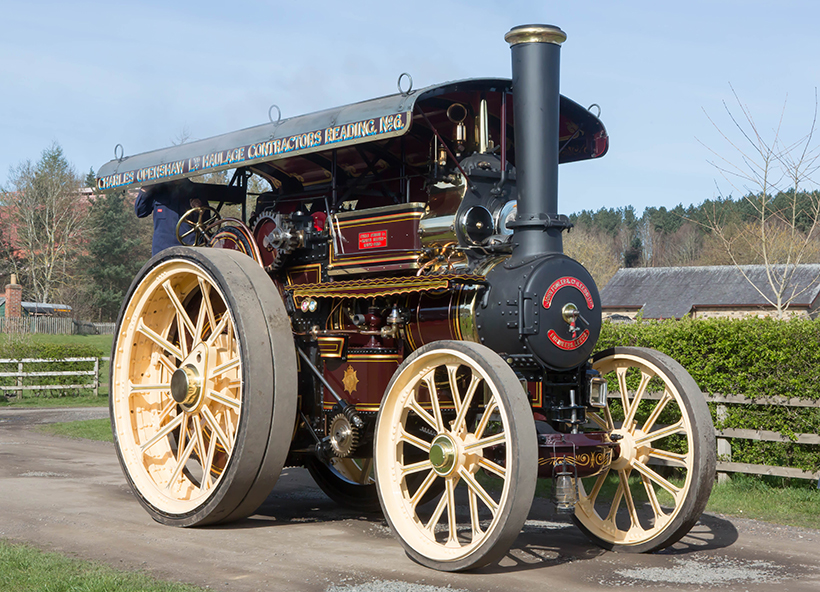
No 41 This 1911 Fowler B6 road locomotive No. 12906 Foremost was new to Charles Openshaw of Reading and used for furniture haulage up until WW1. It bought by Joe and Linda Walker of Derby in 2008, with restoration starting in 2009 and completed in 2013.
Moving away from the Fowler name, but also pulling its weight, was 1913 McLaren 12-ton 8hp road locomotive.
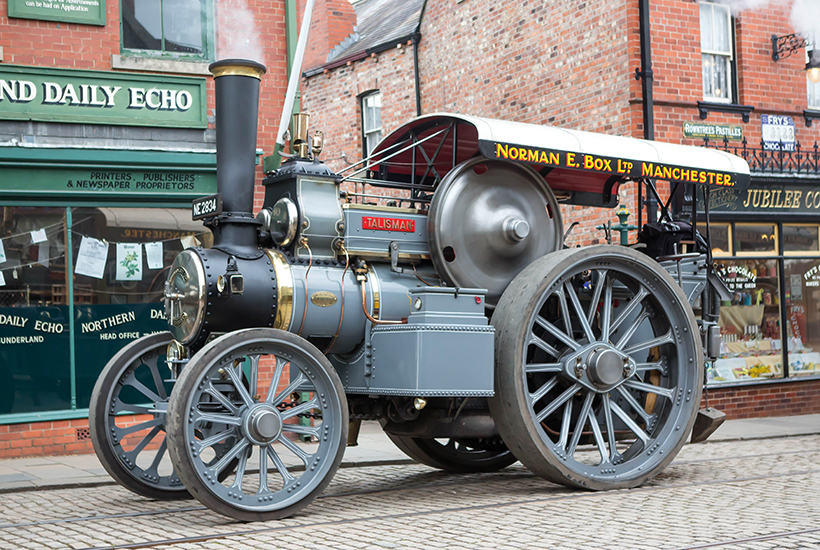
1925 Fowler B6 road locomotive No. 16263 Talisman was built for the heavy haulage firm of Norman E Box of Manchester for hauling large loads in excess of 100 tons around the country. It has been completely rebuilt from a kit of old original and new parts back to ‘as new’ specification.
No. 1421 Captain Scott, which started life with Samuel Whitelocks of Conisbrough, South Yorkshire and was used by them in their quarry for stone haulage. It had a varied life, at the outbreak of WWI, it was requisitioned by the War Dept and was used by the army for haulage duties including the construction of Cranwell and West Wittering aerodromes. After hostilities ceased, Captain Scott moved back to heavy haulage duties at Barton-upon-Humber and later with Percy Naylor of Middle Handley, near Chesterfield, where it was also used for threshing. But from 1945 it sat in a corner of their yard until the 1950s when passed into preservation, with the McLaren being bought by Will Woodward in 2019 after it had been restored by John Blagg.

Side by side at Beamish. 1925 Fowler B6 road locomotive No. 16263 Talisman stands alongside 1911 Fowler B6 road locomotive No. 12906 Foremost for the cameras.
There is no doubt that this haulage demonstration was the highlight of the weekend, and certainly got the cameras clicking. But the other engines and exhibits on site were well worth a look too, and with Beamish’s extensive range of vintage vehicles complementing the visiting vehicles, this Steam Gala is definitely an event that shouldn’t be missed.

1928 Fowler B6 No 17105 Atlas is seen passing 1925 Aveling & Porter D Class 4hp road roller No. 11145 Ayesha on the town’s street.
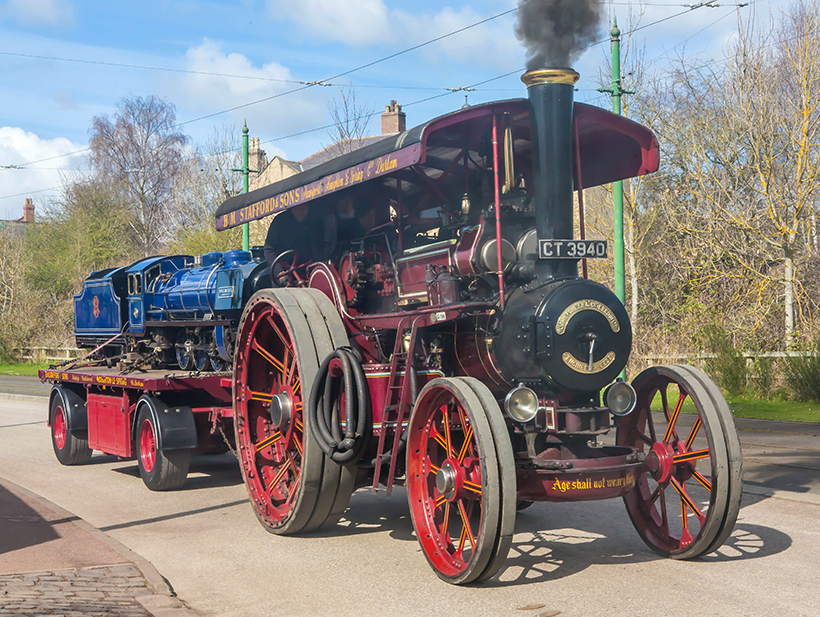
No 45 1920 Fowler l7hp A9 compound road locomotive No 15649 Providence was hauling the Ravenglass & Eskdale Railway’s 1929 Krauss Pacific steam locomotive Whillan Beck, recreating a similar job that it did in the 1960s.
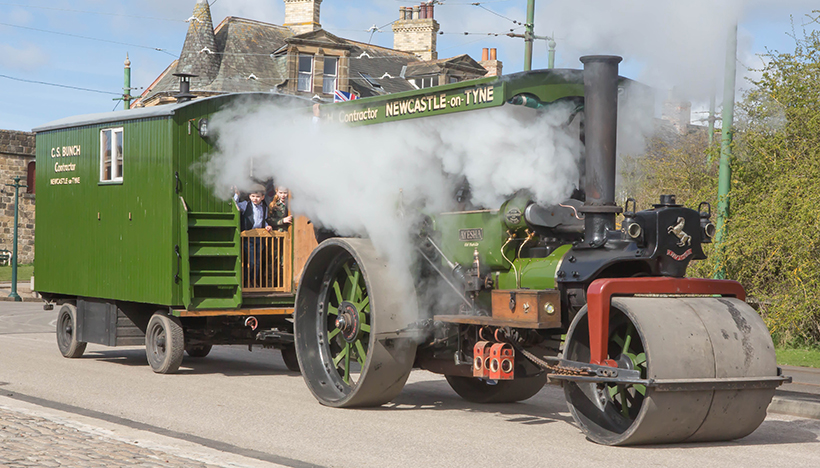
Alan Borthwick’s 1925 Aveling & Porter D Class 4hp roller No. 11145 Ayesha was new to C S Bunch of Jesmond, Newcastle and was used by them until the 1960s. It is seen pulling a period wagon.
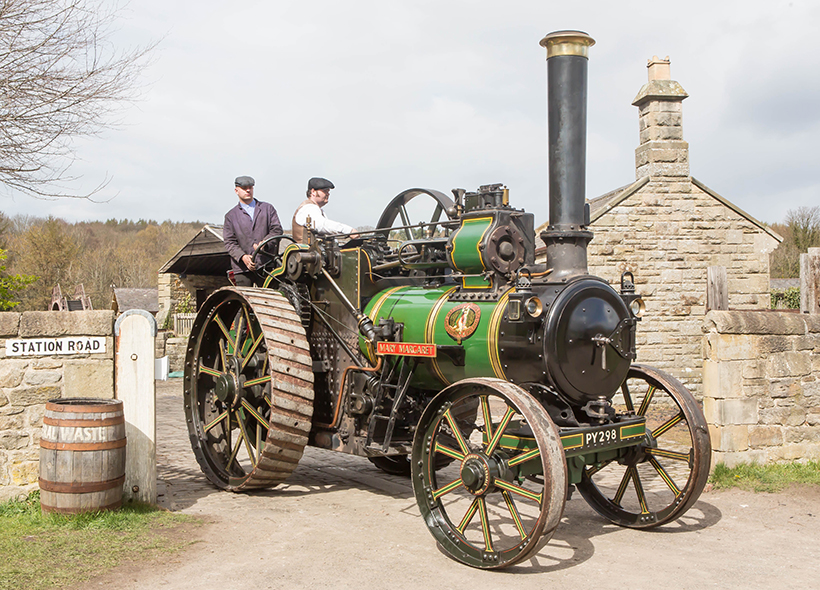
PY 298 is 1889 Marshall 8hp single-cylinder GP engine No 17134 Mary Margaret that was exhibited at The Royal Agricultural Show at Windsor when new. It was bought in 1994 by Michael Davison of Bishop Middleton in County Durham.
This feature comes from the latest issue of Old Glory, and you can get a money-saving subscription to this magazine simply by clicking HERE
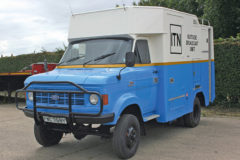
Previous Post
A rare survivor: 1983 Ford A Series

Next Post
1939 Morris Commercial CV11/30 ambulance survival story



